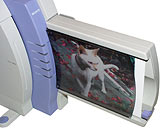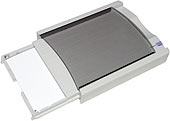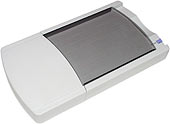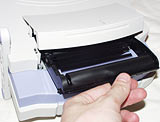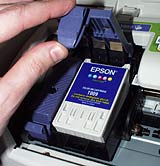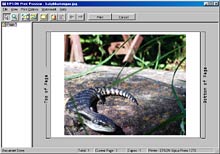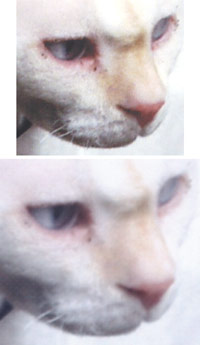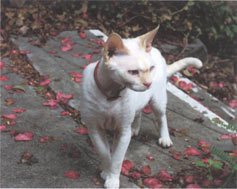
Sony UP-DP10 photo printer
Review date: 17 December 2000. Last modified 03-Dec-2011.Want a photo printer?
Well, here one is. Made by Sony, nice styling, small footprint, plug-and-go operation, good results.
Don't go rushing out to buy it just yet, though, because it is definitely not the only horse in the race.
Sony's UP-DP10 is a photos-only printer; the largest output it can manage is six by four inches, and it can't take ordinary paper. Mind you, it does six by four inches edge-to-edge, with no white border, just like a normal photo print. The DP10 prints on special paper with ends you can easily snap off afterwards, and once the ends are gone, you've got what looks for all the world like a normal minilab print from a film camera, provided that your original image had enough resolution to be reproduced that big without pixels becoming visible.
You can do bordered prints with the DP10 as well, but if you're happy with white space around your pictures, you might as well get an ink jet.
And there's the obvious question.
You see, I already have an ink jet. A very nice ink jet. Epson's Stylus Photo 1270, to be exact; I review it here.
The 1270 is the big A3-size version of Epson's Stylus Photo 870. The 870 can only do A4 size prints, and it retails for $AU750 or so; the 1270 currently costs a bit more than $AU1000, but it can print full A3 area. To do that, though, you have to print a bordered image on slightly bigger-than-A3 paper, then manually crop it down to full A3.
Given that the UP-DP10 costs $AU808.50 from sonystyle.com.au, it's competing directly with the Stylus Photo 870, and with other current photo ink jets - Hewlett-Packard and Canon make some excellent photo printers, though Epson's offerings give slightly better results at the moment.
Purchase price isn't everything, though. Here's how the DP10 stacks up across the board.
Specs
The Epson ink jets can print on all sorts of media - plain paper, coated paper, expensive glossy coated paper, very expensive glossy coated plastic that Epson calls "Photo Quality Glossy Film". Plus, of course, the usual oddities like T-shirt iron-on paper and transparencies and envelopes.
The Sony, on the other hand, prints on only three things - six by four inch 3:2 aspect ratio paper, 134 by 100mm 4:3 aspect ratio paper, and six by four inch self-adhesive photo sticker paper. All of the paper varieties have the extra white end pieces, but you snap them off the ordinary paper, and you peel the printed area off the sticker paper. Provided your image is the right shape and size to cover the whole print area, you always get an edge-to-edge print.
The Epsons are five colour, six ink printers, with one cartridge for black and one multi-ink cartridge for colour - magenta, pale magenta, cyan, pale cyan, and yellow.
The Sony, though, is a dye sublimation or "dye-sub" printer.
Like all other consumer dye sublimation printers - including odd ones like the baby photo printer in Sony's own DCR-TRV820E camcorder, which I review here - the DP10 uses a multi-colour plastic dye-coated ribbon from which its thermal print head transfers pigment onto the page.
This is a conceptually simple system - the printer makes three passes over the page to lay down yellow, magenta and cyan pigment, then you've got your picture. The DP10 then makes another pass and lays a laminate layer over the top of the print, to make it about as durable as a real photo.
You can pick what pattern you want for the laminate on the print - glossy, texture or matte. They're all pretty glossy, really, but there is some difference.
Dye-sub used to be the only way to get a photo-quality printer that consumers could afford, but ink jets have definitely caught up with it, now.
The DP10 has 295 by 295 dot per inch resolution, with 256 gradations possible for each of the three colours. This gives you a full 24 bit colour gamut, and resolutions for the 2:3 and 3:4 aspect ratios of 1162 by 1765 and 1162 by 1563 dots, respectively.
Which is impressive.
But the Epson opposition does 1440 by 720 resolution, with just as wide a colour gamut; in its regular 720dpi photo print mode (1440 doesn't look much better) it can lay almost six times as much detail on a given area. Which is significant, even if you don't think your source images have the resolution to justify it. Fine detail benefits from the extra resolution, as you'll see shortly.
One selling point for the Sony is its smallness. It can lay flat on the table, or you can fix its stands to the side, as I have, and use it upright. In its vertical alignment, the printer's got a very small footprint. The main body of the DP10's only 208 by 71 by 303mm...
...and it's still only about 450mm long when you fit its paper feeder.
The feeder's a nice piece of design. It handles both input and output, with a 25 sheet tray and a 10 sheet receiver built in.
A plastic cap keeps the dust out when the tray's not attached to the printer. It's easy to attach and remove, getting paper in and prints out is simple, and there's even a little pop-up plastic dingus that stops prints falling out of the tray when you don't want them to.
Installing the DP10's ribbon is similarly simple...
...but it's easy enough to install cartridges in the Epson printers, too, and their higher print capacity mean it's a job you'll have to do less often.
Ease of use
The DP10 and the current Stylus Photos all have both parallel and USB connectors, and Windows and Mac drivers (USB-only, for the Mac). You can get the latest drivers for the DP10 from Sony's download page here, and I did.
Setting up all of these printers is a doddle; plug in, install driver, start printing. The DP10 comes with Adobe Photoshop 5.0 LE for Windows and Mac, which is a perfectly good image editing and printing package for home use.
Epson are right on the ball with their print software and its image enhancement features. Traditionally, "auto-enhance" features have been likely to punch up the contrast and sharpness of a picture until it looks like a still from some avant-garde drug culture movie, but the current Stylus Photo drivers do an excellent job on almost any picture when you just pick the Standard PhotoEnhance option in the setup, and leave it at that.
The Sony driver software has far fewer options. Many of the Epson's options are of course irrelevant to the DP10 - the Sony printer only takes three kinds of media, only has one print resolution, and so on - but it lacks the Epson's comprehensive image tweaking, and it definitely lacks the Epson's generally reliable automatic enhancement.
Which makes it rather unfortunate that the Sony software also lacks a print preview.
This is the Stylus Photo print preview. Not flashy, but functional, and it lets you see whether the settings you've chosen work well or not. With proper colour correction software installed you ought not to need this, but in the average home or small business environment a lot of simple clicking of "enhance" buttons happens, and it's nice to be able to see more or less what's been done before you approve the translation of bits into atoms.
Learning by trial and error is much more fun when every error doesn't have to make you pay for a not-so-great print.
Print quality
Prints from the DP10, when you've got the driver settings right, look as good as normal film-camera photo prints. No banding, no streaks, no pixelation, provided your original image was good enough. A professional darkroom will give you a better result from film, but you're unlikely to get better from a normal cheap auto-print place.
But prints from the current Stylus Photos look better than normal photo prints.
The sample at the top is from an A6-size, 720dpi print done with the Stylus Photo 1270 on Photo Quality Glossy Film. The sample at the bottom is from a DP10 print. Don't worry about the difference in colour - the Epson print was done with the Standard PhotoEnhance setting, the Sony one was my third attempt and the point where I said "that'll do". Look, instead, at the detail. Click the picture for a larger image.
This is not a nitpicking you-need-a-microscope-to-see-it difference. On the Sony print, this area's 20.8mm wide (0.818 inches). The excerpt from the slightly smaller Epson print's 17.5mm (0.689 inches) wide in real life. It's a difference you can easily see at normal photo-viewing distances, or further.
The A6 sheet on which the Epson print was made, by the way, is 105 by 148mm. The Stylus Photo can print on no more than 120mm by 99mm of that. Each "A-series" paper size is equal to the next size up, cut in half widthwise; an A6 sheet is exactly one quarter of an A4. In the unlikely event that this information excites you, you can read all about the various size standards here.
So if you print six-by-fours on the Sony, you get about 30% more print area than the Epson gives you on an A6 index card sized sheet. But, of course, you can get larger media for the Epsons, right up to A4 for the 870 or somewhat larger than A3 for the 1270.
The Stylus Photos can do edge-to-edge printing, but only on hundred millimetre (four inch) wide stock. There's a special optional roll feeder for them that lets you print ordinary photos or panoramas. You have to guillotine them off at the ends, of course. One way or another, if you want edge-to-edge from the Epsons, you're going to be cutting some paper.
Print torture
The Sony's laminated prints are pleasingly waterproof, in exactly the way that ink jet prints for years and years totally weren't. But here, also, ink jets have caught up.
See this? This is a little print (60 by 48mm) done with the Stylus Photo 1270, on cheap Canon HR-101 High Resolution Paper. This paper doesn't have a fancy-pants plastic substrate or glossy super-ink-glomming surface, and 200 sheets of it will cost you less than $AU30. Canon make special water resistant paper, but this ain't it.
An old fashioned colour ink jet print on paper like this will, if it gets wet, pretty much instantly turn into a kindergarten finger-paint mud-splotch.
See how the picture now looks blurry and runny? It looks like an older ink jet print on expensive glossy paper that got wet, then was immediately frantically dabbed dry.
Well, the blurry look could have something to do with the fact that the paper's still wet from being grabbed fresh from the printer, without any time for the ink to even finish drying, and boiled in a pot for three minutes.
Even on ordinary paper, current photo ink jet prints should be well and truly splash-proof, and on expensive photo paper they should be pretty much as good as a real photo - and as good as Sony's laminated prints, too. Use Epson Glossy Film with the Stylus Photo and you could stick the edges of your prints together with waterproof tape and make a fully functional, though rather expensive, tent.
Speed
The Sony takes about a minute and a half to do an actual print, plus however much time your computer spends getting the data ready for it. About two minutes all told, for most computers, unless you've chosen to print a ridiculously high resolution file and made your computer flog itself witless.
For a (slightly smaller) A6 print, the Stylus Photo 1270 takes about two minutes and ten seconds, plus image preparation time and however long you spend staring at the print preview - which you don't have to use if you don't want it. The Sony has a speed advantage, but not a big one.
Consumables
Dye sublimation printing is not at all economical.
You see, every time you print one photo, you use one three-colour segment of ribbon. Even if your photo needs practically none of one of the pigments, you still use up that ribbon segment, and you can't use it again. You could perhaps manually rewind the ribbon, but parts of it that've had their pigment used won't work again, so you'd get patchy prints - and, with the DP10, something horrible might happen when you got to the lamination stage.
This is why print packs for the DP10 contain 25 sheets of paper and one 25-print ribbon; you will absolutely definitely run out of both commodities at the exact same time.
Rather stingily, by the way, Sony only provide a lower capacity, ten-prints ribbon with the DP10, and five sheets each of the two kinds of photo paper.
Ink-based printers, of course, work differently. They only squirt ink onto the page when they need to. And while most consumer inkjets have a one-piece colour cartridge which you have to throw away when any one colour runs out, you get to average your ink usage over all of the prints you make with that cartridge. So you generally end up running out of all of the colours at much the same time, and not using up one-25th of, say, your blue pigment, even if you've printed a picture that needs no blue at all.
When you're tinkering around with colour correction and trying to get the final output looking just right, it's often handy to be able to print a little thumbnail of the picture to see if your brilliant idea has resulted in just the effect you're looking for, or turned half of the image into a pool of inky blackness. Even with print preview, it's nice to be able to do a test print.
With the DP10, there's no reason to do that. You use as much ribbon for a one square centimetre test print as you do for a full picture.
Similarly, once an ink jet's started printing, if you see you've made a big mistake (loaded the wrong kind of paper, accidentally printed portrait instead of landscape, whatever), you can abort the print and not waste any more ink. Again, with the DP10, that's not an option. If you've started a print, you might as well finish, since all you save by aborting it is time.
25-sheet-plus-ribbon print packs for the DP10 cost about $AU30 for the paper ones, or about $AU40 for the sticker ones. So, for ordinary photo prints, you're talking a flat $AU1.20 per picture.
Colour cartridges for the Stylus Photo 1270 are about $AU40, street price; black cartridges are about $AU30. A colour cartridge ought to last for about 70 six by four prints, and the black should last a while longer. So if you're doing photo-size prints, you're paying maybe 85 Aussie cents a print for ink. The total per-print price depends on the paper you choose.
Ten sheets of A6-size Photo Quality Glossy Film will cost you less than $AU9. Mind you, a pack of 15 A4 sheets made from the same stuff is more than $AU40.
You don't save a lot if you invest in a guillotine, a roll feeder and a few rolls of glossy paper; the big deal about the roll feeder is that it lets you print panoramas. An eight metre glossy roll's $AU35 or so, and can't possibly fit more than 52 photos; I wouldn't be surprised if, on average, you wasted enough of it that you could only fit about 32 photos, and ended up still spending about a buck a shot for paper. But you'd get nice edge-to-edge glossy pictures just like the Sony's, with higher resolution.
For cheap photo printing on a Stylus Photo, you can get 50 sheets of Epson-branded A6 matte coated paper for about $AU14. These'll give proper 720dpi photo quality results - not as shiny as the Sony prints, but sharper. Total cost per print, about the same as the DP10.
And, of course, if you don't mind paying more per print, you can do much bigger prints on an ink jet than on the DP10. I've done full A3 poster prints on the 1270 of pictures taken with my Olympus C-2500L (reviewed here); the Olympus only has 1712 by 1368 resolution so you can definitely see individual pixels on a print that big, but it's surprising how well it comes up.
Do a maximum-size, ultra-quality "Super A3" 323 by 455mm print on the 1270 and you're probably throwing something like ten bucks worth of ink onto the page, plus maybe five bucks for a single Super A3 sheet of Premium Glossy Photo Paper. Ordinary Photo Quality Glossy paper that size is less than $AU3.50 a sheet, Epson's A3+ Heavyweight Matt paper, suitable for photo prints when you're not interested in gloss, is only about a buck fifty Australian per page.
Anybody seized with a great enthusiasm to print on a Super A3 piece of Photo Quality Glossy Film, by the way, will probably have their enthusiasm dampened somewhat by the fact that one single sheet of the stuff is about $AU100. I am uncertain whether you get to keep the Learjet that delivers it to you.
Of course, you can also just grab a ream of A3 photocopier paper for close to nothing and use that if you like. I've done some black and white graphic art prints on photocopier paper; they look lovely.
Even the alarmingly expensive prints from a photo ink jet are good value, compared with the alternatives. You can go to a desktop publishing output bureau and get a similar quality print, but you'll pay even more.
Actually, there's a good chance that your output-bureau print will in fact be done on a Stylus Photo 1270, because the output quality from the consumer Epsons beats that of many large format professional ink jets. Big pro ink jets' selling points these days are that they print really fast, cost less per page because of huge ink reservoirs, and can print really huge sizes. As far as quality goes, though, it just doesn't need to get any better than Epson have already managed.
The point of all this is that getting a general purpose ink jet gives you lots of choices. You can spend big bucks on huge prints if you want to, or a buck twenty for a snapshot size. And you can also print plain black and white documents on photocopier paper.
The Sony printer, in comparison, is a one trick pony.
Overall
If you want a straightforward, no-nonsense, easy to use photo printer that can't do anything bigger than six by four inches, the DP10's not a bad piece of gear. It doesn't take long to print, the results look nice, and the price per print is OK.
But at more than $AU800, it's competing with absolutely superb hardware from other manufacturers, the best of whom in this department at the moment are Epson. A Stylus Photo 870 is a general purpose printer as well as a remarkably good photo output device, the Epson printers have considerably better software, and so for most users, they're clearly a better product.
I realise that this review comes over as a big rah-rah job for Epson, but I assure you that a brown paper bag of money was not involved. I didn't even get my 1270 for free. I bought it, and I'm glad I did.
Five years ago, I would have swooned over the DP10, but now I'm spoiled. I can take a picture in the garden, walk back into the house, and literally within five minutes have in my hands a gorgeous A4 size print that's only cost me $AU5 or so, all told.
If Sony cut the price of the DP10 in a big way, it could be a great gadget. As it stands, I'm afraid it's stuck in a mighty small niche.
UP-DP10 printer kindly provided by Sony Australia


